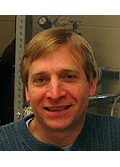
Gregory Hockerman

Associate Professor of Med Chem Mol Pharm
B.S., Olivet Nazarene College, 1983
Ph.D., University of Wisconsin-Madison, 1991
hockerma@purdue.edu
765-496-3874
Integrative Neuroscience
Active Mentor - currently hosting PULSe students for laboratory rotations and recruiting PULSe students into the laboratory; serves on preliminary exam committees
Current Research Interests:
Voltage-gated calcium channels are key players in a large array of physiological processes including contraction of cardiac, vascular and skeletal muscle, release of neurotransmitters from nerve terminals, gene expression, and hormone secretion. The long-range goal of our studies is to contribute to the development of drugs that can modulate voltage-gated calcium channels in a tissue and type selective manner to treat cardiovascular disease, stroke, and type II diabetes. Recent work in my lab has centered on describing the binding site for the BZP diltiazem in the Cav1.2 L-type channel, as well as the Ca2+ binding site in the channel that modulates the affinity for diltiazem and verapamil. We are currently using chemical oxidizing reagents in conjunction with mutant channels to understand how ischemia my modulate channel activity. Our current research is focused on the role of Cav1.2 and 1.3 channels in insulin secreting cells. My lab has developed mutant versions of Cav1.2 and 1.3 that are resistant to the DHP class of L-type channel blockers (Cav1.2/DHPi and Cav1.3/DHPi), but remain sensitive to the BZP diltiazem. After introducing these mutant channels into insulin-secreting INS-1 cells, we are able to functionally isolate either Cav1.2 or Cav1.3 channels by "turning off" endogenous L-type channels with the DHP nifedipine. Using this approach, we found that Cav1.3, but not Cav1.2, channels are coupled to glucose-stimulated insulin secretion from INS-1 cells. Further, we found that Cav1.3, but not Cav1.2, channels are coupled to glucose-stimulated oscillations in intracellular Ca2+ concentrations. Finally, we found that insulin secretion stimulated by the incretin peptide GLP-1 is preferentially coupled to Cav1.3. Our lab is also collaborating with other groups to study the roles of Cav1.2 and 1.3 channels in cardiac myocytes and endocrine cells using the same strategy.
Selected Publications:
Walsh, K.B., Zhang, J., Fuseler, J., Hilliard, N., and Hockerman, G.H. Adenoviral-mediated expression of dihydropyridine-insensitive L-type calcium channels in cardiac ventricular myocytes and fibroblasts. European Journal of Pharmacology In Press (2007).
Liu, G., Jacobo, S. M. P., Hilliard, N., and Hockerman, G.H. Cyclic AMP potentiates coupling of both Cav1.2 and Cav1.3 to glucose-stimulated insulin secretion at sub-maximal glucose concentration through Epac and PKA in INS-1 cells. J. Pharmacol. Exp. Ther. 318:152-160 (2006).
Wang, X., Hockerman, G.H., Green, H.W., Babbs, C.F., Mohammad, S.I., Gerrard, D., Latour, M.A., London, B., Hannon, K.M., and Pond, A.L. Merg1A K+ channel induces skeletal muscle atrophy by activating the ubiquitin proteosome pathway. FASEB J. 20:1531-1533 (2006). FJ Express Full-length Article 20:E803-811 (2006).
Vikman, J., Ma, X., Hockerman, G.H., Rorsman, P., and Eliasson, L. Antibody inhibition of SNAP-25 and syntaxin 1A clusters reduces rapid exocytosis in insulin-secreting cells. J. Mol. Endocrinol. 36: 503-515 (2006).
Dilmac, N., Hilliard, N., and Hockerman, G.H. Molecular determinants of frequency-dependence and Ca2+ potentiation of verapamil block in the pore region of Cav1.2. Mol. Pharmacol. 66:1236-1247 (2004).
Spelbrink, R., Dilmac, N., Allen, A., Smith, T.J., Shah, D., and Hockerman, G.H. The alfalfa antifungal defensin, MsDef1, is a trans-kingdom calcium channel inhibitor. Plant Physiol. 135:2055-2067 (2004).
Zhao, Y., Sadtler, B., Lin, M., Hockerman, G.H., and Wei, A. Nanoprobe implantation into mammalian cells by cationic transfection. Chem. Comm. 2004 (7):784-785 (2004).
Liu, G., Hilliard, N., and Hockerman, G.H. Preferential coupling of Cav1.3 to glucose-induced [Ca2+]i in the pancreatic beta cell line INS-1. Mol. Pharmacol. 65:1269-1277 (2004)
Dilmac, N., Hilliard, N., and Hockerman, G.H. Molecular determinants of Ca2+ potentiation of diltiazem block and Ca2+-dependent inactivation in the pore region of Cav1.2 Mol. Pharmacol. 64:491-501 (2003)
Liu, G., Dilmac, N., Hilliard, N., and Hockerman, G.H. Cav1.3 is preferentially coupled to glucose-stimulated insulin secretion in the pancreatic beta-cell line INS-1. J. Pharmacol. Exp. Ther. 305:271-278 (2003)
Gage, M.J., Rane, S.G., Hockerman, G.H., and Smith, T.J. The virally encoded fungal toxin KP4 blocks L-type voltage-gated calcium channels. Mol. Pharmacol. 61: 936-944 (2002).
Hockerman, G.H., Dilmac, N., Scheuer, T., and Catterall, W.A. Molecular determinants of diltiazem block in domains IIIS6 and IVS6 of L-type calcium channels. Mol. Pharmacol. 58: 1264-1270 (2000
- Faculty Profile

